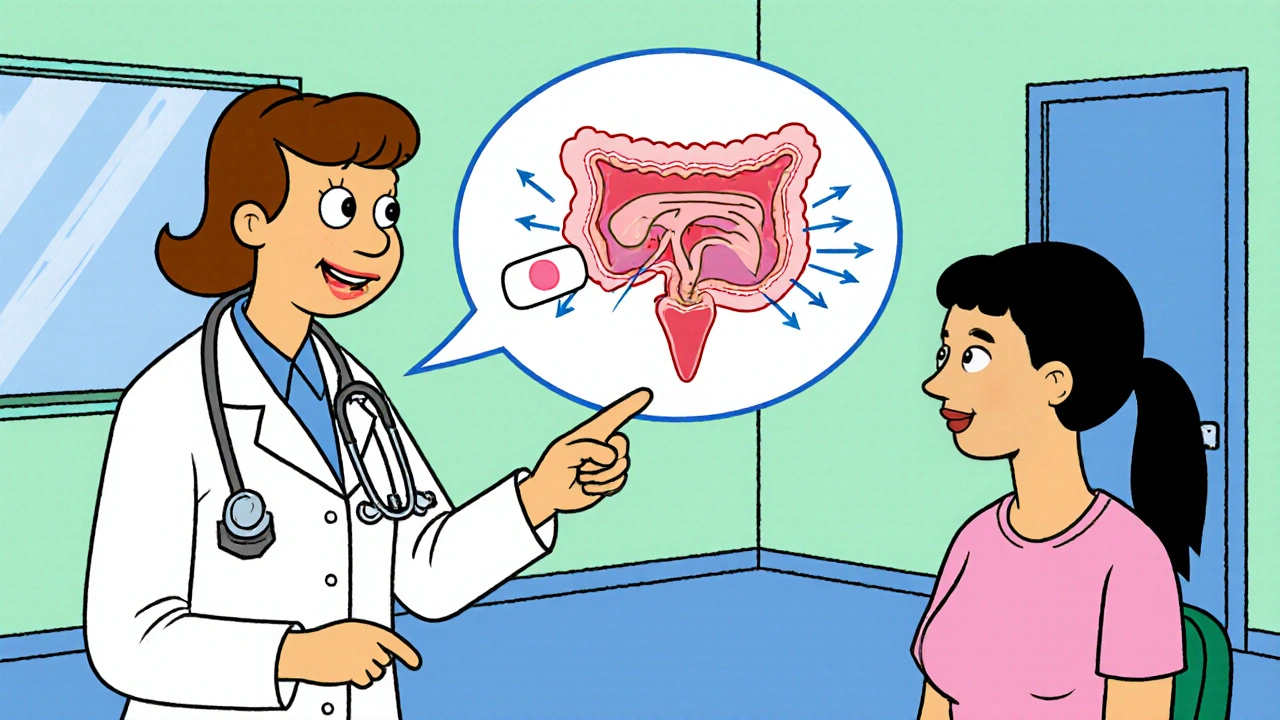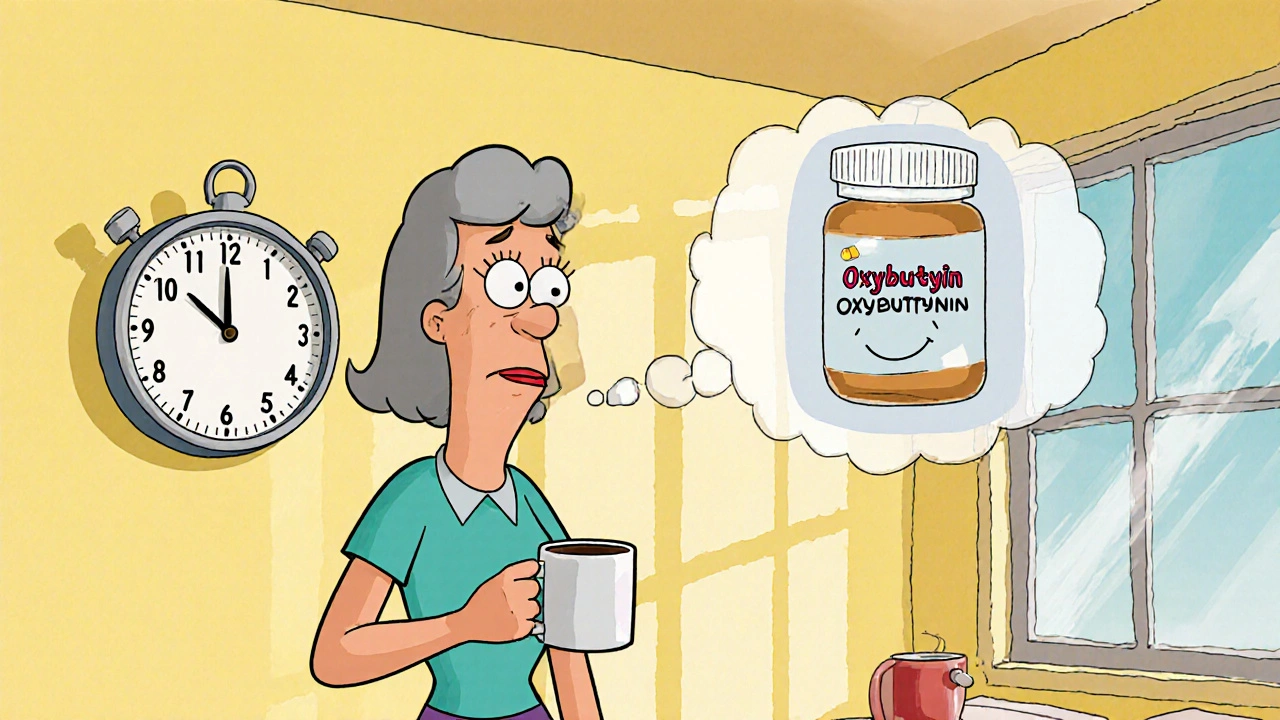When it comes to annoying trips to the bathroom, many women wish there was a simple fix. Oxybutynin is a prescription medication that targets the muscles over‑reacting in the bladder, offering relief for conditions like urgency, frequency, and occasional leakage. Below you’ll find a plain‑English guide on how it works, who should consider it, and what to watch out for.
Key Takeaways
- Oxybutynin relaxes the bladder’s detrusor muscle, reducing sudden urges.
- It’s approved for both overactive bladder and urge urinary incontinence in women.
- Typical start dose for adult women is 5 mg once daily, often increased to 10 mg.
- Common side effects include dry mouth, constipation, and blurry vision; most fade with time.
- Work with a urologist or GP to tailor dosage and combine with bladder‑training exercises.
What Is Oxybutynin?
Oxybutynin is an anticholinergic medication that has been on the market since the 1970s. It belongs to a class of drugs that block the action of acetylcholine, a neurotransmitter that tells the bladder muscle to contract. By dampening this signal, the medication helps the bladder stay relaxed longer, lowering the frequency of sudden urges.
How It Works in a Woman’s Bladder
The bladder’s main contractile layer is called the Detrusor Muscle. When the nervous system sends acetylcholine, the muscle tightens, signaling the need to empty. In overactive bladder (OAB), this feedback loop is hyper‑sensitive, causing urge episodes even when the bladder is only partially full. Oxybutynin’s anticholinergic action reduces the muscle’s responsiveness, allowing more urine to collect before the urge hits.
Female Bladder Problems It Treats
Women experience a range of urinary issues, often linked to hormonal changes, pregnancy, or pelvic floor weakness. The two most common problems addressed by oxybutynin are:
- Overactive Bladder - a chronic condition marked by urgency, frequency (more than eight trips a day), and sometimes nocturia (waking at night to pee).
- Urinary Incontinence - specifically urge incontinence, where the sudden need to void leads to leakage before reaching a restroom.
Both conditions can severely affect daily life, confidence, and even relationships. Oxybutynin offers a pharmacological way to regain control.

Dosage and Administration for Women
- Start with 5 mg taken once daily, usually in the evening to reduce daytime drowsiness.
- If symptoms persist after a week, a doctor may increase the dose to 10 mg once daily. Some patients split the dose (5 mg twice daily) to smooth out side‑effects. \n
- Extended‑release (ER) tablets are also available (e.g., 5 mg once daily) and tend to cause fewer peaks in blood concentration, which can lessen dry mouth.
- Take the pill with water; food does not dramatically affect absorption, but a light snack can help if you’re prone to stomach upset.
- Never double‑dose if you miss a pill; simply skip it and continue with the next scheduled dose.
Always follow a prescriber’s guidance - they may adjust based on age, kidney function, or other medications you’re using.
Benefits You Can Expect
Clinical trials show that about 60‑70% of women report a noticeable drop in urgency episodes within four weeks. Most experience:
- Fewer nocturnal trips - often a reduction of 2‑3 awakenings per night.
- Decreased total daily voids - from 10‑12 down to 6‑8.
- Improved confidence in social situations, work, and travel.
These gains translate into better sleep, less interruption of daily activities, and a boost in overall quality of life.
Possible Side Effects and How to Manage Them
Because oxybutynin blocks acetylcholine throughout the body, it brings a handful of predictable side effects. Most are mild and fade as your body adjusts.
- Dry mouth - sip water throughout the day, chew sugar‑free gum, or use saliva substitutes.
- Constipation - increase fiber intake, stay hydrated, and consider a gentle stool softener.
- Blurred vision - avoid driving if you notice visual changes until they settle.
- Drowsiness or dizziness - take the dose in the evening; avoid alcohol and sedating meds if possible.
- Heart palpitations - rare, but if you feel irregular beats, contact your doctor promptly.
Should side effects persist beyond two weeks, a clinician may switch you to a different anticholinergic or a beta‑3 agonist such as mirabegron.
Who Should Avoid Oxybutynin?
While many women tolerate the drug well, some groups need caution:
- People with narrow‑angle glaucoma - anticholinergics can increase eye pressure.
- Those with severe gastrointestinal blockage or ulcer disease.
- Pregnant or breastfeeding women - safety data are limited, so doctors usually opt for non‑drug strategies first.
- Patients on strong CYP3A4 inhibitors (e.g., ketoconazole) - the drug level may rise, increasing side‑effect risk.
Always disclose your full medical history to your prescriber.
Alternatives and When to Consider Them
If oxybutynin isn’t right for you, other medications or treatments can fill the gap. Below is a quick comparison of the most common oral options.
| Drug | Typical Adult Dose (Women) | Key Side Effects | Duration of Action | FDA Approval Year |
|---|---|---|---|---|
| Oxybutynin | 5‑10 mg once daily (IR) or 5 mg ER | Dry mouth, constipation, blurred vision | 6‑8 hours (IR), 24 hours (ER) | 1975 |
| Tolterodine | 2 mg once daily | Dry mouth, headache | 24 hours | 2004 |
| Solifenacin | 5 mg once daily (may increase to 10 mg) | Dry mouth, constipation, urinary retention | 24 hours | 2004 |
When choosing, weigh how often you’ll need to remember a dose, how severe your side‑effects are, and any other meds you take. A urologist can run a simple trial to see which works best.
Lifestyle and Non‑Drug Strategies to Boost Results
Medication isn’t a magic wand. Pairing oxybutynin with bladder‑training techniques can double the benefit.
- Timed voiding - set a schedule (e.g., every 2‑3 hours) and stick to it, even if you don’t feel the urge.
- Pelvic floor physical therapy - a Pelvic Floor Physical Therapy specialist teaches you how to contract and relax the muscles that support the bladder, reducing leakage.
- Fluid management - limit caffeine and alcohol, which irritate the bladder, but stay hydrated enough to keep urine dilute.
- Weight control - excess weight adds pressure on the pelvic floor; modest weight loss can ease symptoms.
Talking to a Urologist or a specialized continence nurse can help you design a personalized plan.
Frequently Asked Questions
Can I take oxybutynin if I’m pregnant?
Safety data in pregnancy are limited, so doctors usually recommend non‑drug options first. If the benefits outweigh the risks, a low dose might be considered, but only under close supervision.
How long does it take to feel better?
Most women notice a reduction in urgency within 1‑2 weeks, with full benefit often emerging after 4‑6 weeks of consistent use.
Is the extended‑release form better?
ER tablets provide steadier blood levels, which usually means fewer peaks of dry mouth and drowsiness. They’re a good first‑line choice for many women.
Can I combine oxybutynin with other bladder meds?
Combination therapy is possible but must be managed by a clinician to avoid excessive anticholinergic load, which can affect cognition and heart rate.
What should I do if I miss a dose?
Skip the missed pill and resume your regular schedule. Doubling up can increase side effects.
In short, oxybutynin can be a game‑changer for women battling overactive bladder or urge incontinence, especially when paired with lifestyle tweaks and professional guidance. Talk to your healthcare provider to see if it fits your situation.


Comments (5)
Aaron Kuan
25 Oct, 2025Oxybutynin feels like a secret weapon for restless bladders.
Brett Witcher
9 Nov, 2025The pharmacological profile of oxybutynin aligns with anticholinergic mechanisms that attenuate detrusor overactivity. Clinical guidelines endorse its use as first-line therapy for urge urinary incontinence in adult females. Dosage titration from 5 mg to 10 mg should be individualized based on tolerability and renal function. Nevertheless, practitioners must remain vigilant regarding anticholinergic burden in polypharmacy contexts.
Benjamin Sequeira benavente
24 Nov, 2025Don’t let bladder urgency dictate your schedule-grab the prescription and stick to the regimen! Consistency is key, so take your dose every evening and pair it with bladder‑training drills. You’ll see progress within weeks if you stay disciplined.
Shannon Stoneburgh
9 Dec, 2025While the guideline sounds solid, many women still complain about dry mouth and can't tolerate it.
Nathan Comstock
24 Dec, 2025Listen, the American way of handling health is to trust the doctor’s script, but the truth is you’re just swapping one problem for another. Oxybutynin may calm the bladder, but it also drags your mind into fog. If you’re not careful, you’ll end up dependent on a drug that messes with your core. The only real solution is to strengthen the pelvic floor, not to hide behind pills.